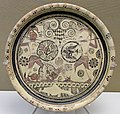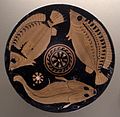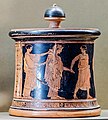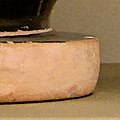Typology of Greek vase shapes
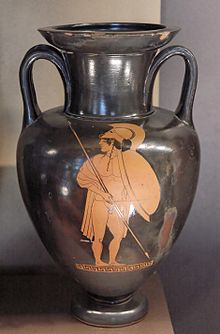
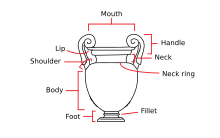
The pottery of ancient Greece has a long history and the form of Greek vase shapes has had a continuous evolution from Minoan pottery down to the Hellenistic period. As Gisela Richter puts it, the forms of these vases find their "happiest expression" in the 5th and 6th centuries BC, yet it has been possible to date vases thanks to the variation in a form’s shape over time, a fact particularly useful when dating unpainted or plain black-gloss ware.
The task of naming Greek vase shapes is by no means a straightforward one (by convention the term "vase" has a very broad meaning in the field, covering anything that is a vessel of some sort). The endeavour by archaeologists to match vase forms with those names that have come down to us from Greek literature began with Theodor Panofka’s 1829 book Recherches sur les veritables noms des vases grecs, whose confident assertion that he had rediscovered the ancient nomenclature was quickly disputed by Gerhard and Letronne.
A few surviving vases were labelled with their names in antiquity; these included a
The following vases are mostly Attic, from the 5th and 6th centuries, and follow the
Overview
Greek pottery may be divided into four broad categories, given here with common types:[1]
- storage and transport vessels, including the amphora, pithos, pelike, hydria, stamnos, pyxis,
- mixing vessels, mainly for symposia or male drinking parties, including the krater, dinos, and kyathos,
- jugs and cups, several types of oinochoe and loutrophoros,
- vases for oils, perfumes and cosmetics, including the large lekythos, and the small aryballos, alabastron, and askos.
In addition, various standard types might be used as external grave-markers (in extra-large versions, sometimes in stone), funerary
Vase shapes
- Storage
-
Amphora type A, c. 520 BC.
-
Amphora type B.
-
Amphora type C.
-
Neck amphora, c. 520 BC.
-
Belly amphora, with hardly a distinct neck
-
Ovoid neck amphora
-
Nikosthenic amphora, c. 530 BC.
-
Panathenaic amphora, always large
-
Pseudo-panathenaic amphora, c. 500 BC.
-
Pointed amphora
-
Transport amphorae
-
Hydria-black figure type
-
Hydria-red figure type orKalpis
-
Lebes Gamikos, for weddings, c. 340 BC
-
Stamnos, c. 480–470 BC.
- Cups
-
Kantharos type A
-
Kantharos type B
-
Kylixtype A
-
Kylix type B
-
kylix
-
Eye-cup, painted with eyes
-
Komast cup, Athenian black-figure, with short stem, angled "offset" lip.[2]
-
Lip cup, with the main painting just below the lip; the stem and footr are lost in this example
-
Merrythought cup, with distinctive "wishbone" handles
-
Mastos, breast-shaped cup with pointed nipple base; handles optional
-
Mastoid cup, like a mastos but with flat base and often handles
-
Phiale
-
Rhyton, c. 430 BCE.
-
Skyphos, c. 740 BC
-
Glaux skyphos
-
Hermogenes skyphos
- Jugs
-
Oenochoe Shape 1
-
Oinochoe Shape 2
-
Oinochoe Shape 3
-
Oinochoe Shape 7
-
Olpe
- Small oil and perfume
-
Alabastron, small holders for oil or perfume
-
Pyriform Aryballos
-
Globular aryballos
-
Fancy aryballos in the form of three cockle shells, 6th century BC
-
Acorn lekythos
-
Deianeira lekythos, c. 550 BC.
-
Shoulder or secondary lekythos, c. 500 BC.
-
Standard or cylinder lekythos c.490 BCE.
-
Squat lekythos
-
"Huge" Loutrophoros, 330 BC
- Other
-
Lekanis
-
Nestoris (Trozella)
-
Pinax (plaque)
-
Phormiskos (here a terracotta model)
-
Plate
-
Fish Plate
-
Pyxis, c. 470 BC.
-
Pointed pyxis
Styles of lips and feet
- Lip styles
-
Flaring lip
-
Inverted Echinus lip
-
Lip in several degrees
-
Torus lip
- Foot styles
-
Disk foot
-
Echinus foot
See also
- Ancient Greek art
- Black-figure pottery
- Red-figure pottery
- Greek terracotta figurines
- List of Greek Vase Painters
Notes
- ^ Woodford, 12-14; "Shapes" (see menu at left), Beazley Archive, Oxford
- ^ Beazley, Cups
- ^ Beazley, Cups
References
- Gisela M. A. Richter, Marjorie J. Milne, Shapes and Names of Athenian Vases, Metropolitan Museum of art, New York, 1935.
Further reading
- Von Bothmer, Dietrich (1987). Greek vase painting. New York: The Metropolitan Museum of Art. ISBN 0870990845.




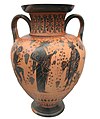







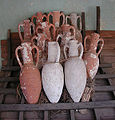







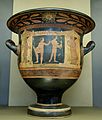

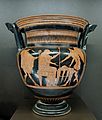











![Komast cup, Athenian black-figure, with short stem, angled "offset" lip.[2]](http://upload.wikimedia.org/wikipedia/commons/thumb/2/23/Komast_cup_Louvre_E742.jpg/120px-Komast_cup_Louvre_E742.jpg)


![Siana cup, Similar to Komast, with slightly longer stem, and painted on the inside.[3]](http://upload.wikimedia.org/wikipedia/commons/thumb/6/6c/Siana_cup_Louvre_F67.jpg/120px-Siana_cup_Louvre_F67.jpg)


































